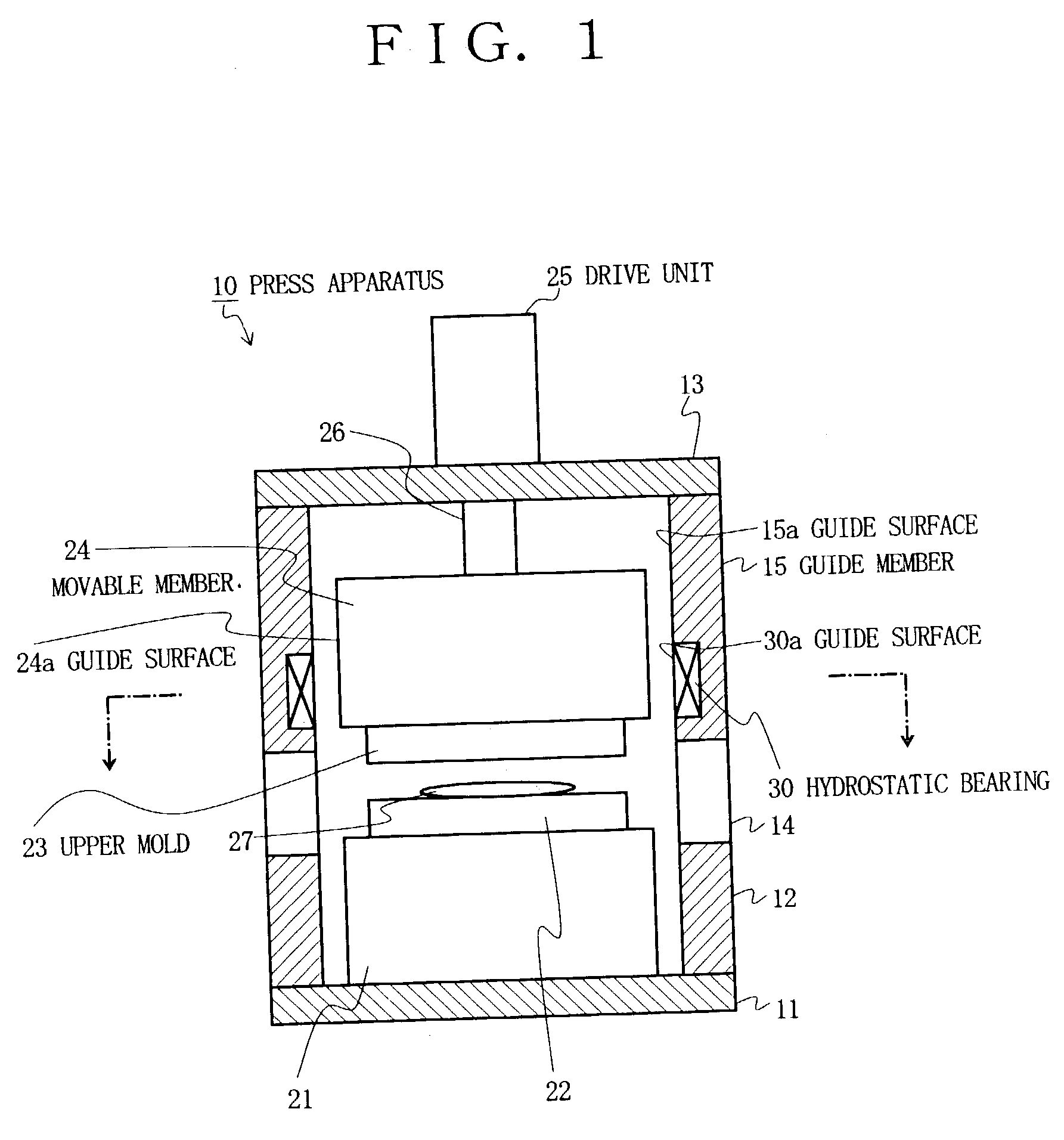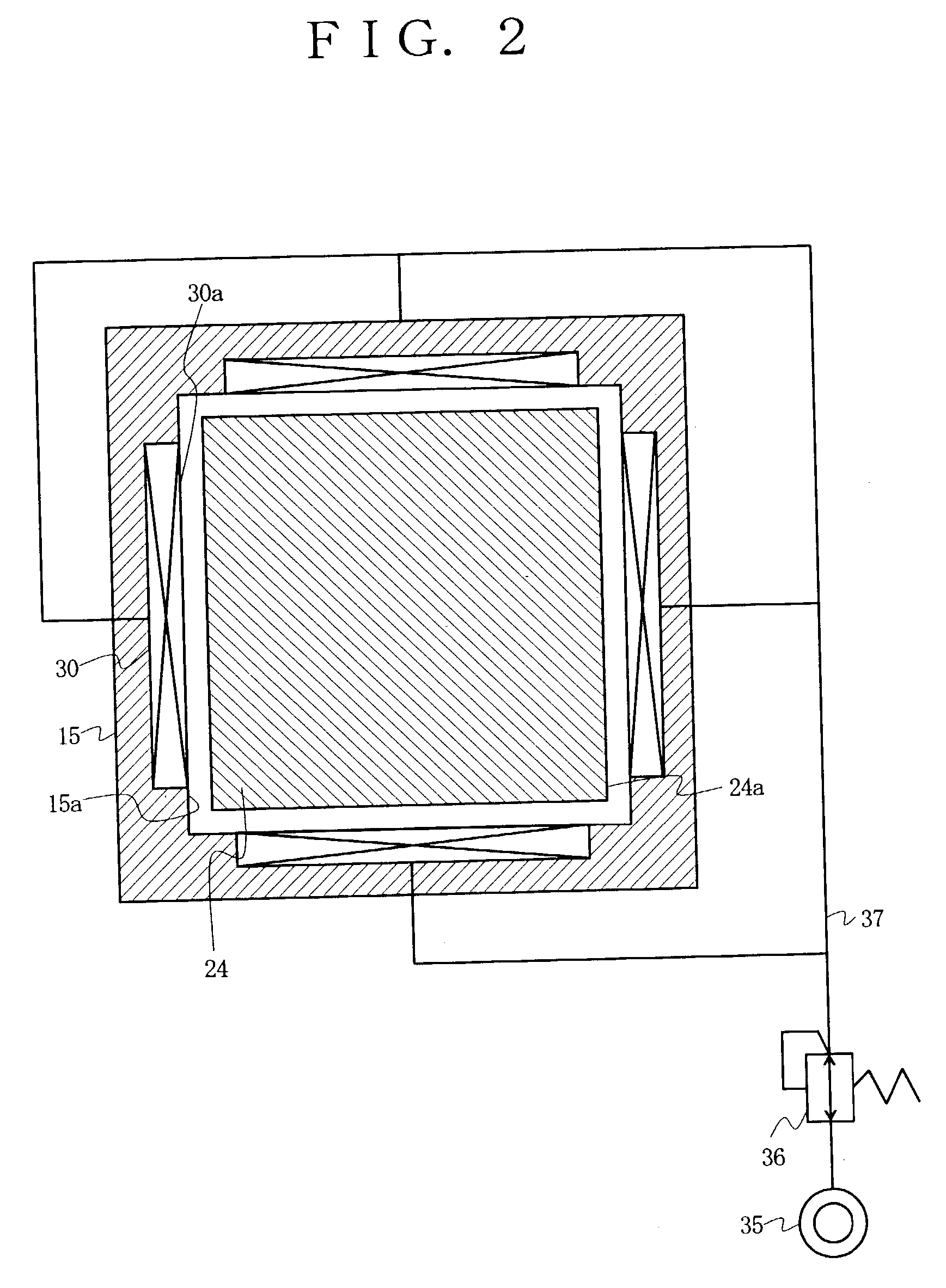Press apparatus
a press and cylinder technology, applied in the field of press cylinders, can solve the problems of affecting the quality of molded glass or resin objects, and breaking of the upper or lower molds,
- Summary
- Abstract
- Description
- Claims
- Application Information
AI Technical Summary
Benefits of technology
Problems solved by technology
Method used
Image
Examples
first embodiment
[0046] FIG. 1 is a vertical sectional view showing the configuration of a press apparatus according to the present invention. FIG. 2 is a sectional view taken along line I-I of FIG. 1.
[0047] In FIG. 1, reference numeral 10 denotes a press apparatus; reference numeral 11 denotes a base frame, which serves as a portion of the frame of the press apparatus 10; and reference numeral 12 denotes a guide frame, which serves as a portion of the frame of the press apparatus 10. The guide frame 12 assumes the form of a rectangular prismatic tube in a standing condition, and a lower end portion thereof is attached to the upper surface of the base frame 11.
[0048] A ceiling frame 13, which serves as a portion of the frame of the press apparatus 10, is attached to an upper end portion of the guide frame 12. The base frame 11 and the ceiling frame 13 assume the form of a rectangular plate so as to close opposite end openings of the guide frame 12 in the form of a rectangular prismatic tube.
[0049] A...
second embodiment
[0087] FIG. 5 is a transverse sectional view showing the configuration of a press apparatus according to the present invention.
[0088] In the first embodiment, the hydrostatic bearings 30 are mounted on the corresponding guide surfaces 15a of the guide member 15. The mounting position of the hydrostatic bearings 30 is determined such that the guide surfaces 24a face, at least partially, the corresponding guide surfaces 30a of the hydrostatic bearings 30 at all times during vertical movement of the movable member 24. However, in the case where the stroke of vertical movement of the movable member 24 is very long as compared with the vertical dimension of the guide surfaces 24a, it is difficult for the guide surfaces 24a to face, at least partially, the corresponding guide surfaces 30a of the hydrostatic bearings 30 at all times.
[0089] Thus, in the present embodiment, the hydrostatic bearings 30 are mounted on the four corresponding guide surfaces 24a of the movable member 24 in an emb...
third embodiment
[0094] FIG. 6 is a vertical sectional view showing the configuration of a press apparatus according to the present invention; FIG. 7 is a sectional view taken along line III-III of FIG. 6; and FIG. 8 is a sectional view taken along line IV-IV of FIG. 6.
[0095] A drive unit 40 of the press apparatus 10 of the present embodiment is constituted by portions of side walls of a movable member 41 and portions of side walls of the guide frame 12. The upper mold 23, which serves as a movable mold, is mounted on the movable member 41. As shown in FIG. 7, the movable member 41 assumes the form of a prism having a rectangular cross section, preferably a square cross section. The vertically extending four side wall surfaces of the movable member 41 function as guide surfaces 41a. The movable member 41 is made of, for example, ceramic or a stainless steel alloy. However, no particular limitation is imposed on material for the movable member 41. The upper mold 23 is mounted directly on the lower su...
PUM
| Property | Measurement | Unit |
|---|---|---|
| temperature | aaaaa | aaaaa |
| temperature | aaaaa | aaaaa |
| pressure | aaaaa | aaaaa |
Abstract
Description
Claims
Application Information
 Login to View More
Login to View More - R&D
- Intellectual Property
- Life Sciences
- Materials
- Tech Scout
- Unparalleled Data Quality
- Higher Quality Content
- 60% Fewer Hallucinations
Browse by: Latest US Patents, China's latest patents, Technical Efficacy Thesaurus, Application Domain, Technology Topic, Popular Technical Reports.
© 2025 PatSnap. All rights reserved.Legal|Privacy policy|Modern Slavery Act Transparency Statement|Sitemap|About US| Contact US: help@patsnap.com



